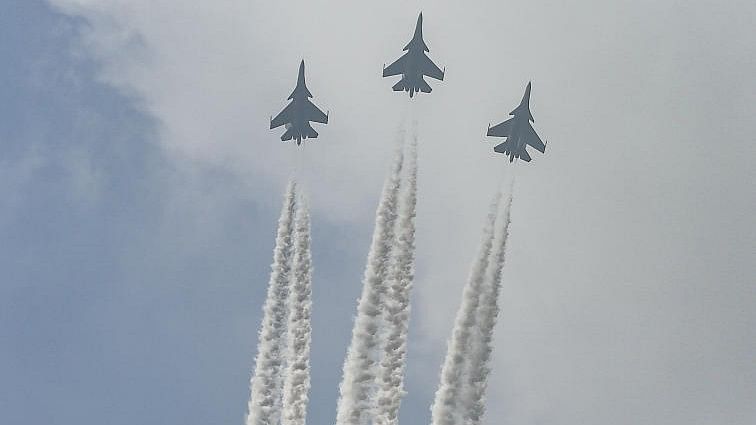
Representative image of India's fighter jets.
Credit: PTI Photo
Fair winds beckon the Indian Air Force (IAF) with the Cabinet Committee on Security clearing the much-awaited indigenous Advanced Medium Combat Aircraft (AMCA) fighter jet project on March 7. This clears the deck for a fifth-generation stealth fighter — before this decade is out.
The Aeronautical Development Agency (ADA), which is under the Defence Research and Development Organisation (DRDO), and the Hindustan Aeronautics Limited (HAL) will jointly make the aircraft with several private sector defence companies expected to participate in the Rs 15,000 crore project. The avionics for the AMCA will be developed at the new Flight Control System facility in Bengaluru while the United States aerospace major General Electric’s F-414 engine will power the prototype of the aircraft.
An aircraft’s stealth capabilities depend on several cutting-edge technologies. The shape of the aircraft deflects radar waves, and its fuselage is coated with a secret material that absorbs nearly 90 per cent of radar waves. The aircraft’s engines operate so quietly that their heat signature — a tell-tale trail for infrared search and track (IRST) systems — is almost imperceptible to ground and airborne defences. The communication and navigation aids on board the aircraft use electromagnetic wavelengths which are difficult for enemy air defence systems (ADS) to detect.
All these bequeath a game-changing nature on stealth warplanes enabling them to play multiple roles such as ground attack, bombing, reconnaissance, and intelligence gathering. In other words, these shadowy flying machines can dominate enemy airspace with impunity, confounding hapless ADS that are clueless about these phantom attackers.
No wonder stealth technology remains so zealously guarded. While there are at least 10 known stealth warplane development programmes in the world, only three countries have successfully produced these highly-prized force multipliers: the US, Russia, and China. It is, however, widely believed that the Chinese stole many stealth secrets from the US to build the J-20 which is touted by Beijing as a 5th generation aircraft — a claim dismissed by many analysts.
So that leaves the American F-22 Raptor and the F-35A Lightning II, along with Russia’s Su-57 and Su-75 Checkmate as the only truly 5th generation stealth-capable fighter jets around. Even the Su-57 designation as a 5th-generation aircraft is often questioned by aviation experts.
It is against this background that the pace of India’s indigenous development of the AMCA stands out, especially given the stop-start nature of the project since it was officially announced in 2007. Initially, India collaborated with Russia to build a stealth fighter based on the Su-57. But the joint Indo-Russian Fifth Generation Fighter Aircraft (FGFA) proposal soon ran into rough weather as the IAF had misgivings about the engines and stealth dynamics of the Su-57 template that Russia offered. In 2014, when the government’s ‘Make in India’ initiative kicked in, it effectively buried the FGFA programme, leaving the DRDO to go it alone on building the AMCA in a single-seat, twin-engine stealth fighter configuration.
India’s defence aerospace engineers deserve full credit for getting the AMCA’s design on the drawing board — and hopefully off it — in a span of 22 years. Even the US and Russia took over 23 years to flight-test their first 5th-generation stealth fighters, which compares favourably with what India could achieve if the AMCA makes its maiden flight in the next five years.
That said, there should only be room for cautious optimism at the moment given the disappointing history of military aircraft manufacturing in the subcontinent. Over the last 50 years, the HAL has built two jet fighters: the HF-24 Marut fighter bomber and the delta-winged Tejas Light Combat Aircraft. The former, inducted into the IAF in 1960, did not prove cost-effective and never lived up to its promise because of its inability to fly at supersonic speeds. The Tejas, despite spending well over three decades on the drawing board, underwent long and expensive tweaks before finally entering service with the IAF in 2016.
Regardless, DRDO sources seem confident that the AMCA programme will meet all its deadlines as the ADA has already developed many, if not most, of the 5th-generation technologies required for building the aircraft. This will be music to the ears of a beleaguered IAF as it tries to shore up the depleting strength of its fighter fleet which currently stands at 32 squadrons. The Air Force needs to add at least 10 more squadrons to maintain its sanctioned number of 42 squadrons — easier said than done since most legacy fighters such as the MiG-21s and Mirage-2000s are scheduled to be phased out in less than 10 years.
The IAF is, therefore, pinning its hopes on inducting the newly-ordered Tejas LCA, along with upgraded Su-30 MKIs, in numbers to bolster its fleet strength. The addition of 40 AMCA
Mark-1s when they enter production, and subsequently 80 more AMCA Mark-2s — with 6th generation capabilities (such as Directed Energy Weapons) and accompanied by unarmed AI drones that attack targets independently — will ensure adequate fleet strength after the Su-30 MKIs are gone. The Air Force would then be able to breathe easy, as phantom fighters like the AMCA Mark-2s rule the skies of the mid-century battlefields.
Prakash Chandra is former editor of the Indian Defence Review. He writes on aerospace and strategic affairs.
Disclaimer: The views expressed above are the author's own. They do not necessarily reflect the views of DH.